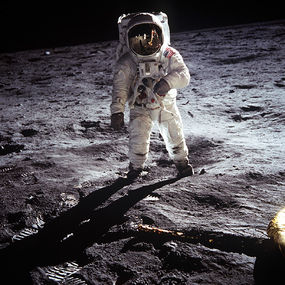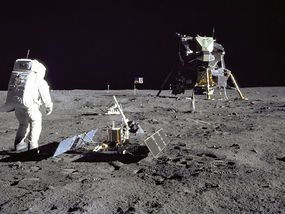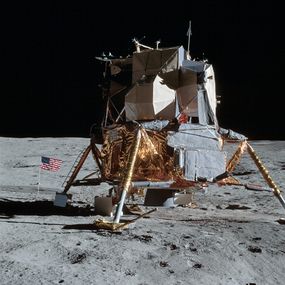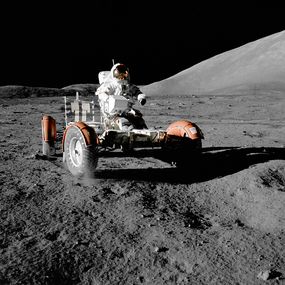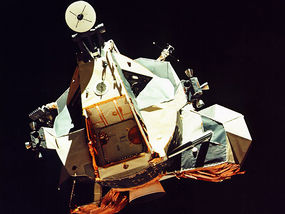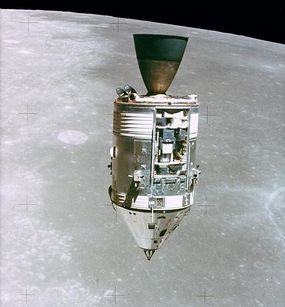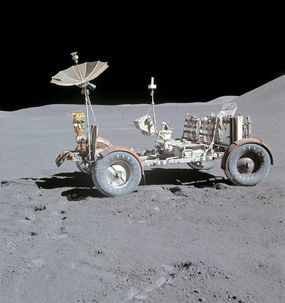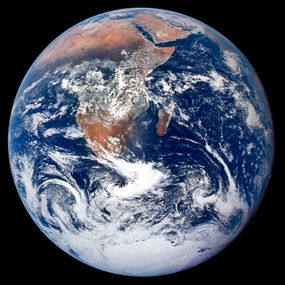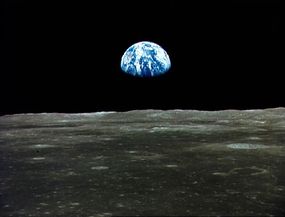Apollo program/Gallery: Difference between revisions
Jump to navigation
Jump to search

imported>Milton Beychok m (Added another photo) |
imported>Milton Beychok m (Added another photo) |
||
| (7 intermediate revisions by the same user not shown) | |||
| Line 4: | Line 4: | ||
|+ '''Apollo program photos''' | |+ '''Apollo program photos''' | ||
|- valign=bottom | |- valign=bottom | ||
|{{Image|Apollo 11 image 2.jpg|left|285px|The first manned landing on the Moon was successfully accomplished by the Apollo 11 mission. Astronaut Neil Armstrong took this photograph of fellow astronaut Edwin ("Buzz") Aldrin walking on the Moon's surface during the lunar landing.}} | |{{Image|Apollo 11 image 2.jpg|left|285px|'''Apollo 11:''' The first manned landing on the Moon was successfully accomplished by the Apollo 11 mission. Astronaut Neil Armstrong took this photograph of fellow astronaut Edwin ("Buzz") Aldrin walking on the Moon's surface during the lunar landing.}} | ||
|{{Image|Apollo 11 image 1.jpg|left|285px|During Apollo 11, the first manned landing on the Moon, Astronaut Neil Armstrong took this photograph of fellow astronaut Edwin ("Buzz") Aldrin preparing to deploy a scientific experiment package he had unloaded from the Lunar Module.}} | |{{Image|Apollo 11 image 1.jpg|left|285px|'''Apollo 11:''' During Apollo 11, the first manned landing on the Moon, Astronaut Neil Armstrong took this photograph of fellow astronaut Edwin ("Buzz") Aldrin preparing to deploy a scientific experiment package he had unloaded from the Lunar Module.}} | ||
|{{Image|Aldrin and Apollo11 Lunar Module.jpg|left|285px|Astronaut Neil Armstrong took this photograph of fellow Astronaut Edwin ("Buzz") Aldrin looking at the Apollo 11 Lunar Module after Aldrin had unloaded and deployed a seismic experiment package and a laser ranging experiment (for measuring the distance from the Moon to the Earth).}} | |{{Image|Aldrin and Apollo11 Lunar Module.jpg|left|285px|'''Apollo 11:''' Astronaut Neil Armstrong took this photograph of fellow Astronaut Edwin ("Buzz") Aldrin looking at the Apollo 11 Lunar Module after Aldrin had unloaded and deployed a seismic experiment package and a laser ranging experiment (for measuring the distance from the Moon to the Earth).}} | ||
|- valign=bottom | |- valign=bottom | ||
|{{Image|Apollo 11 Lunar Module.jpg|left|285px|The Apollo 11 Lunar Module separated from the Command Module (while in lunar orbit) and ready to descend to the Moon's surface. Astronauts Edwin Aldrin and Neil Armstrong are in the Lunar Module. Astronaut Michael Collins remained in lunar orbit with the Command Module to await return of Aldrin and Armstrong.}} | |{{Image|Apollo 11 Lunar Module.jpg|left|285px|'''Apollo 11:''' The Apollo 11 Lunar Module separated from the Command Module (while in lunar orbit) and ready to descend to the Moon's surface. Astronauts Edwin Aldrin and Neil Armstrong are in the Lunar Module. Astronaut Michael Collins remained in lunar orbit with the Command Module to await return of Aldrin and Armstrong.}} | ||
|{{Image|Apollo 14 Lunar Module.jpg|left|285px|The Apollo 14 Lunar Module on the Moon. Astronauts Alan Shepard and Edgar Mitchell had already deployed the U.S. flag and other items. Note the laser ranging retro reflector at foot of the Landing Module ladder. The crumpled gold foil, used as thermal shielding of the Module, was removed when items were unloaded. Astronaut Stuart Roosa remained in the Command Module in lunar orbit, awaiting the return of Shepard and Mitchell.}} | |{{Image|Apollo 11 Lunar Module ready to descend.jpg|left|285px|'''Apollo 11:''' Another view of the Apollo 11 Lunar Module separated from the Command Module (while in lunar orbit) and ready to descend to the Moon's surface. Astronauts Edwin Aldrin and Neil Armstrong are in the Lunar Module. Astronaut Michael Collins remained in lunar orbit with the Command Module to await return of Aldrin and Armstrong.}} | ||
|{{Image|Apollo 14 Lunar Module.jpg|left|285px|'''Apollo 14:''' The Apollo 14 Lunar Module on the Moon. Astronauts Alan Shepard and Edgar Mitchell had already deployed the U.S. flag and other items. Note the laser ranging retro reflector at foot of the Landing Module ladder. The crumpled gold foil, used as thermal shielding of the Module, was removed when items were unloaded. Astronaut Stuart Roosa remained in the Command Module in lunar orbit, awaiting the return of Shepard and Mitchell.}} | |||
|- valign=bottom | |- valign=bottom | ||
|{{Image|Blue Marble.jpg|left|285px|Earth seen from Apollo 17 traveling to the Moon. Photo extends from the Mediterranean Sea to the Antarctic polar ice cap. Note heavy clouds over Southern Hemisphere. A part of Africa is visible. The Arabian Peninsula is seen at the northeastern edge of Africa. The large island off east coast of Africa is the Malagasy Republic.}} | |{{Image|Apollo 17 Lunar Rover.jpg|left|285px|'''Apollo 17:''' Astronaut Eugene Cernan makes a short checkout of the Lunar Roving Vehicle (LRV) during early part of the Apollo 17 extravehicular activity (EVA) at the lunar landing site. This photo of the Lunar Rover is prior to loading it up with equipment and was taken by astronaut Harrison H. Schmitt.}} | ||
|{{Image|Apollo 17 Lunar Module ascent stage.jpg|left|285px|'''Apollo 17:''' Ascent stage of the Apollo 17 Lunar Module during return of astronauts Cernan and Schmitt to the Command Module (in lunar orbit) at end of Moon surface landing. The large, square opening seen in the photo is the hatch for ingress to and egress from the 2-man crew cabin. Photo was taken by astronaut Ronald Evans in the Command Module.}} | |||
|{{Image|Apollo 15 CM in lunar orbit.jpg|left|285px|'''Apollo 15:''' The Apollo 15 Command Module in lunar orbit (with astronaut Alfred Worden onboard), as photographed by astronauts David Scott and/or James Irwin in the Lunar module ascent stage as they returned to dock with the Command Module after finishing their stay and activities on the Moon's surface.}} | |||
|- valign=bottom | |||
|{{Image|Apollo 15 Lunar Rover.jpg|left|285px|'''Apollo 15:''' The battery-powered, 4-wheeled Lunar Rover during the Apollo 15 landing on the Moon. It was driven for a total of 27.8 km in 3 hours of driving time. The longest single traverse it made was 12.5 km and the maximum distance it reached from the Luner Module was 5.0 km.}} | |||
|{{Image|Blue Marble.jpg|left|285px|'''Apollo 17:''' Earth seen from Apollo 17 traveling to the Moon. Photo extends from the Mediterranean Sea to the Antarctic polar ice cap. Note heavy clouds over Southern Hemisphere. A part of Africa is visible. The Arabian Peninsula is seen at the northeastern edge of Africa. The large island off east coast of Africa is the Malagasy Republic.}} | |||
|{{Image|Earthrise over the Moon.jpg|left|285px|Photo of the planet Earth rising over the horizon of the Moon, against the black background of space. It was taken from the Apollo 11 spacecraft during the Apollo 11 mission in July 1969.}} | |||
|- | |||
|{{Image|Diagram-saturn-v-launch-vehicle-english-units.jpg|left|285px|Diagram of the Saturn V launch vehicle used in the Apollo missions. The Saturn V launch vehicle for the Apollo moon missions. The entire assembly weighed 2,900,000 kg (6,400,000 pounds) and was 110 m (363 feet) long at liftoff. It consisted of 5 parts: 3 rocket stages, an instrument unit, and the Apollo spacecraft.}} | |||
|} | |} | ||
